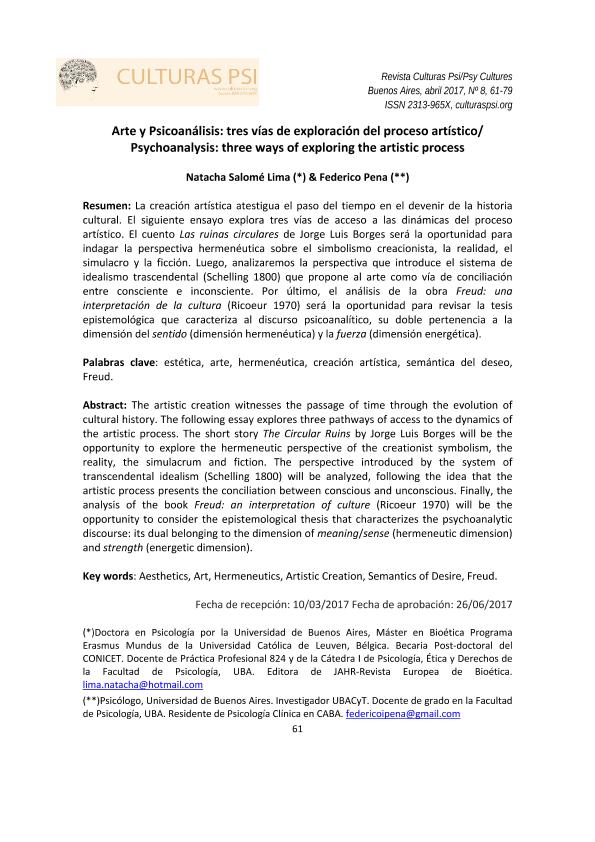Mostrar el registro sencillo del ítem
dc.contributor.author
Lima, Natacha Salomé

dc.contributor.author
Pena, Federico Ignacio
dc.date.available
2019-05-16T19:09:15Z
dc.date.issued
2017-06
dc.identifier.citation
Lima, Natacha Salomé; Pena, Federico Ignacio; Arte y Psicoanálisis: tres vías de exploración del proceso artístico; Instituto de Desarrollo Económico y Social; Culturas psi; 8; 6-2017; 61-79
dc.identifier.issn
2313-965X
dc.identifier.uri
http://hdl.handle.net/11336/76562
dc.description.abstract
La creación artística atestigua el paso del tiempo en el devenir de la historia cultural. El siguiente ensayo explora tres vías de acceso a las dinámicas del proceso artístico. El cuento Las ruinas circulares de Jorge Luis Borges será la oportunidad para indagar la perspectiva hermenéutica sobre el simbolismo creacionista, la realidad, el simulacro y la ficción. Luego, analizaremos la perspectiva que introduce el sistema de idealismo trascendental (Schelling 1800) que propone al arte como vía de conciliación entre consciente e inconsciente. Por último, el análisis de la obra Freud: una interpretación de la cultura (Ricoeur 1970) será la oportunidad para revisar la tesis epistemológica que caracteriza al discurso psicoanalítico, su doble pertenencia a la dimensión del sentido (dimensión hermenéutica) y la fuerza (dimensión energética).
dc.description.abstract
The artistic creation witnesses the passage of time through the evolution of cultural history. The following essay explores three pathways of access to the dynamics of the artistic process. The short story The Circular Ruins by Jorge Luis Borges will be the opportunity to explore the hermeneutic perspective of the creationist symbolism, the reality, the simulacrum and fiction. The perspective introduced by the system of transcendental idealism (Schelling 1800) will be analyzed, following the idea that the artistic process presents the conciliation between conscious and unconscious. Finally, the analysis of the book Freud: an interpretation of culture (Ricoeur 1970) will be the opportunity to consider the epistemological thesis that characterizes the psychoanalytic discourse: its dual belonging to the dimension of meaning/sense (hermeneutic dimension) and strength (energetic dimension).
dc.format
application/pdf
dc.language.iso
spa
dc.publisher
Instituto de Desarrollo Económico y Social
dc.rights
info:eu-repo/semantics/openAccess
dc.rights.uri
https://creativecommons.org/licenses/by-nc-sa/2.5/ar/
dc.subject
Estética
dc.subject
Arte
dc.subject
Hermenéutica
dc.subject
Deseo
dc.subject.classification
Psicología

dc.subject.classification
Psicología

dc.subject.classification
CIENCIAS SOCIALES

dc.title
Arte y Psicoanálisis: tres vías de exploración del proceso artístico
dc.title
Psychoanalysis: three ways of exploring the artistic process
dc.type
info:eu-repo/semantics/article
dc.type
info:ar-repo/semantics/artículo
dc.type
info:eu-repo/semantics/publishedVersion
dc.date.updated
2019-05-13T16:40:55Z
dc.journal.number
8
dc.journal.pagination
61-79
dc.journal.pais
Argentina

dc.journal.ciudad
Ciudad Autónoma de Buenos Aires
dc.description.fil
Fil: Lima, Natacha Salomé. Consejo Nacional de Investigaciones Científicas y Técnicas; Argentina. Universidad de Buenos Aires. Facultad de Psicología; Argentina
dc.description.fil
Fil: Pena, Federico Ignacio. Universidad de Buenos Aires. Facultad de Psicología; Argentina
dc.journal.title
Culturas psi
dc.relation.alternativeid
info:eu-repo/semantics/altIdentifier/url/http://ppct.caicyt.gov.ar/index.php/culturaspsi/article/view/11152
Archivos asociados
